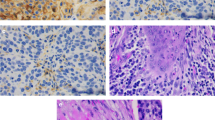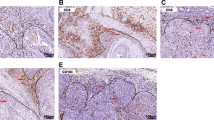Abstract
Objective
Systemic inflammatory response index (SIRI) values and tumor-infiltrating lymphocytes (TILs) are associated with the prognosis of various tumors. There is minimal evidence of those two as prognostic markers in laryngeal squamous cell carcinoma (LSCC). In this study, we aimed to examine the predictive value of SIRI and tumor-infiltrating CD3+/CD4+/CD8+ T cells in the prognosis of patients who underwent partial or total laryngectomy.
Study design
A total of 78 patients with LSCC who underwent total or partial laryngectomy at the Eye, Ear, Nose, and Throat Hospital of Fudan University between 2013 and 2015 were retrospectively analyzed.
Methods
The tumor tissues of 78 LSCC patients were retrospectively evaluated using immunohistochemical staining for CD3+ /CD4+ /CD8+ -cells. The overall survival (OS) and disease-free survival (DFS) rates were recorded using the Kaplan–Meier method.
Results
Patients with high immunoscore (IS) (3–4) had prolonged survival (P < 0.001 for OS). High SIRI values were independently associated with poorer OS and DFS (P = 0.018 for OS; P = 0.016 for DFS). CD8+ TILs and SIRI values showed a- negative association (P < 0.01). Patients with low SIRI values and high IS had better 5-year OS and DFS than those with high SIRI values and low IS (P < 0.001 for OS; P = 0.0014 for DFS). Patients with ‘hot’ tumor had a higher 5-year OS than those with ‘excluded’ or ‘cold’ phenotype.
Conclusions
The SIRI values and the density of TILs may help predict LSCC patients' outcomes after surgery. The combination of SIRI and IS may be a new component of the tumor, nodes, and metastases (TNM) classification of cancer and prognostic factor for T-cell-target immunotherapy.



Similar content being viewed by others
References
Barua S, Fang P, Sharma A, Fujimoto J, Wistuba I, Rao AUK, Lin SH (2018) Spatial interaction of tumor cells and regulatory T cells correlates with survival in non-small cell lung cancer. Lung Cancer 117:73–79
Chao B, Ju X, Zhang L, Xu X, Zhao Y (2020) A novel prognostic marker systemic inflammation response index (SIRI) for operable cervical cancer patients. Front Oncol 10:766
Chen Y, Jin M, Shao Y, Xu G (2019) Prognostic value of the systemic inflammation response index in patients with adenocarcinoma of the oesophagogastric junction: a propensity score-matched analysis. Dis Markers 2019:4659048
Chen LY, Weng WB, Wang W, Chen JF (2021) Analyses of high-risk factors for cervical lymph node metastasis in laryngeal squamous cell carcinoma and establishment of nomogram prediction model. Ear Nose Throat J 100(5):657–662
Diakos CI, Charles KA, McMillan DC, Clarke SJ (2014) Cancer-related inflammation and treatment effectiveness. Lancet Oncol 15(11):e493-503
Fridman WH, Pages F, Sautes-Fridman C, Galon J (2012) The immune contexture in human tumours: impact on clinical outcome. Nat Rev Cancer 12(4):298–306
Galon J, Bruni D (2019) Approaches to treat immune hot, altered and cold tumours with combination immunotherapies. Nat Rev Drug Discov 18(3):197–218
Galon J, Lanzi A (2020) Immunoscore and its introduction in clinical practice. Q J Nucl Med Mol Imaging 64(2):152–161
Galon J, Pages F, Marincola FM, Thurin M, Trinchieri G, Fox BA, Gajewski TF, Ascierto PA (2012) The immune score as a new possible approach for the classification of cancer. J Transl Med 10:1
Galon J, Mlecnik B, Bindea G, Angell HK, Berger A, Lagorce C, Lugli A, Zlobec I, Hartmann A, Bifulco C et al (2014) Towards the introduction of the “Immunoscore” in the classification of malignant tumours. J Pathol 232(2):199–209
Geng Y, Zhu D, Wu C, Wu J, Wang Q, Li R, Jiang J, Wu C (2018) A novel systemic inflammation response index (SIRI) for predicting postoperative survival of patients with esophageal squamous cell carcinoma. Int Immunopharmacol 65:503–510
Goto R, Hirota Y, Aruga T, Horiguchi S, Miura S, Nakamura S, Takimoto M (2020) The number of FoxP3-positive tumor-infiltrating lymphocytes in patients with synchronous bilateral breast cancer. Breast Cancer 27(4):586–593
Hanahan D, Weinberg RA (2011) Hallmarks of cancer: the next generation. Cell 144(5):646–674
Kolaczkowska E, Kubes P (2013) Neutrophil recruitment and function in health and inflammation. Nat Rev Immunol 13(3):159–175
Lahane ST, Lahane TP, Harwani N, Parekh R (2020) Uveoscleral metastasis in laryngeal carcinoma. Indian J Ophthalmol 68(8):1681–1683
Lea D, Haland S, Hagland HR, Soreide K (2014) Accuracy of TNM staging in colorectal cancer: a review of current culprits, the modern role of morphology and stepping-stones for improvements in the molecular era. Scand J Gastroenterol 49(10):1153–1163
Lee JS, Won HS, Sun S, Hong JH, Ko YH (2018) Prognostic role of tumor-infiltrating lymphocytes in gastric cancer: a systematic review and meta-analysis. Medicine (baltimore) 97(32):e11769
Mantovani A, Schioppa T, Porta C, Allavena P, Sica A (2006) Role of tumor-associated macrophages in tumor progression and invasion. Cancer Metastasis Rev 25(3):315–322
Miksch RC, Schoenberg MB, Weniger M, Bosch F, Ormanns S, Mayer B, Werner J, Bazhin AV, D'Haese JG (2019) Prognostic impact of tumor-infiltrating lymphocytes and neutrophils on survival of patients with upfront resection of pancreatic cancer. Cancers (Basel) 11(1)
Nachalon Y, Reicher Y, Alkan U, Levi L, Bachar G, Popovtzer A (2020) Prognostic factors for survival and nonfunctional larynx in patients with squamous cell carcinoma of the larynx. Laryngoscope 130(5):1202–1205
Nguyen N, Bellile E, Thomas D, McHugh J, Rozek L, Virani S, Peterson L, Carey TE, Walline H, Moyer J et al (2016) Tumor infiltrating lymphocytes and survival in patients with head and neck squamous cell carcinoma. Head Neck 38(7):1074–1084
Pages F, Mlecnik B, Marliot F, Bindea G, Ou FS, Bifulco C, Lugli A, Zlobec I, Rau TT, Berger MD et al (2018) International validation of the consensus immunoscore for the classification of colon cancer: a prognostic and accuracy study. Lancet 391(10135):2128–2139
Qi Q, Zhuang L, Shen Y, Geng Y, Yu S, Chen H, Liu L, Meng Z, Wang P, Chen Z (2016) A novel systemic inflammation response index (SIRI) for predicting the survival of patients with pancreatic cancer after chemotherapy. Cancer 122(14):2158–2167
Sharpe G, Camoes Costa V, Doube W, Sita J, McCarthy C, Carding P (2019) Communication changes with laryngectomy and impact on quality of life: a review. Qual Life Res 28(4):863–877
Siegel RL, Miller KD, Fuchs HE, Jemal A (2021) Cancer statistics, 2021. CA Cancer J Clin 71(1):7–33
Sun G, Dong X, Tang X, Qu H, Zhang H, Zhao E (2019) The prognostic value of immunoscore in patients with colorectal cancer: a systematic review and meta-analysis. Cancer Med 8(1):182–189
Sun L, Hu W, Liu M, Chen Y, Jin B, Xu H, Du S, Xu Y, Zhao H, Lu X et al (2020) High systemic inflammation response index (SIRI) indicates poor outcome in gallbladder cancer patients with surgical resection: a single institution experience in China. Cancer Res Treat
Tan KW, Chong SZ, Wong FH, Evrard M, Tan SM, Keeble J, Kemeny DM, Ng LG, Abastado JP, Angeli V (2013) Neutrophils contribute to inflammatory lymphangiogenesis by increasing VEGF-A bioavailability and secreting VEGF-D. Blood 122(22):3666–3677
Tian C, Jing H, Wang C, Wang W, Cui Y, Chen J, Sha D (2021) Prognostic role of tumour-infiltrating lymphocytes assessed by H&E-stained section in gastric cancer: a systematic review and meta-analysis. BMJ Open 11(1):e044163
Valero C, Pardo L, Sansa A, Garcia Lorenzo J, Lopez M, Quer M, Leon X (2020) Prognostic capacity of systemic Inflammation Response Index (SIRI) in patients with head and neck squamous cell carcinoma. Head Neck 42(2):336–343
Wang L, Zhou Y, Xia S, Lu L, Dai T, Li A, Chen Y, Gao E (2020a) Prognostic value of the systemic inflammation response index (SIRI) before and after surgery in operable breast cancer patients. Cancer Biomark 28(4):537–547
Wang Z, Zeng Q, Li Y, Lu T, Liu C, Hu G (2020b) Extranodal extension as an independent prognostic factor in laryngeal squamous cell carcinoma patients. J Cancer 11(24):7196–7201
Yang L, Huang Y, Zhou L, Dai Y, Hu G (2019) High pretreatment neutrophil-to-lymphocyte ratio as a predictor of poor survival prognosis in head and neck squamous cell carcinoma: systematic review and meta-analysis. Head Neck 41(5):1525–1535
Zeng Y, Zeng Y, Yin H, Chen F, Wang Q, Yu X, Zhou Y (2021) Exploration of the immune cell infiltration-related gene signature in the prognosis of melanoma. Aging (albany NY) 13(3):3459–3482
Zhang XM, Song LJ, Shen J, Yue H, Han YQ, Yang CL, Liu SY, Deng JW, Jiang Y, Fu GH et al (2018) Prognostic and predictive values of immune infiltrate in patients with head and neck squamous cell carcinoma. Hum Pathol 82:104–112
Zhang D, Tang D, Heng Y, Zhu XK, Zhou L, Tao L, Lu LM (2021) Prognostic impact of tumor-infiltrating lymphocytes in laryngeal squamous cell carcinoma patients. Laryngoscope 131(4):E1249–E1255
Zhou L, Li Y, Gao W, Huangfu H, Wen S, Zhang C, Zhao Q, Dong Z, Qu C, Li G et al (2019) Assessment of tumor-associated immune cells in laryngeal squamous cell carcinoma. J Cancer Res Clin Oncol 145(7):1761–1772
Funding
This study was supported by Clinical Research Plan of SHDC (No. SHDC2020CR6011), the Science and Technology Commission of Shanghai Municipality under Grant (16411950100), the National Natural Science Foundation of China (82203506, 82103316, 81772878, 30972691), and the Shanghai Municipal Science and Technology Foundation under Grant (11JC1410802).
Author information
Authors and Affiliations
Contributions
Tian Wang, Duo Zhang, and Lei Tao: Study concepts and study design. Tian Wang and Di Tang: Data acquisition. Tian Wang, Duo Zhang, and Li-ming Lu: Data analysis and interpretation. Tian Wang and Yu Heng: Statistical analysis. Tian Wang and Duo Zhang: Manuscript preparation. Tian Wang and Duo Zhang: Manuscript editing. Li-ming Lu and Lei Tao: Manuscript review.
Corresponding authors
Ethics declarations
Conflict of interest
The authors declare no potential conflicts of interest.
Additional information
Publisher's Note
Springer Nature remains neutral with regard to jurisdictional claims in published maps and institutional affiliations.
Supplementary Information
Below is the link to the electronic supplementary material.


Rights and permissions
Springer Nature or its licensor (e.g. a society or other partner) holds exclusive rights to this article under a publishing agreement with the author(s) or other rightsholder(s); author self-archiving of the accepted manuscript version of this article is solely governed by the terms of such publishing agreement and applicable law.
About this article
Cite this article
Wang, T., Zhang, D., Tang, D. et al. The role of systemic inflammatory response index (SIRI) and tumor-infiltrating lymphocytes (TILs) in the prognosis of patients with laryngeal squamous cell carcinoma. J Cancer Res Clin Oncol 149, 5627–5636 (2023). https://doi.org/10.1007/s00432-022-04469-1
Received:
Accepted:
Published:
Issue Date:
DOI: https://doi.org/10.1007/s00432-022-04469-1




